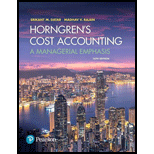
Horngren's Cost Accounting: A Managerial Emphasis (16th Edition)
16th Edition
ISBN: 9780134475585
Author: Srikant M. Datar, Madhav V. Rajan
Publisher: PEARSON
expand_more
expand_more
format_list_bulleted
Textbook Question
Chapter 16, Problem 16.20MCQ
Earl’s Hurricane Lamp Oil Company produces both A-1 Fancy and B Grade Oil. There are approximately $9,000 in joint costs that Earl may allocate using the relative sales value at splitoff or the net realizable value approach. Before splitoff, A-1 sells for $20,000 while B grade sells for $40,000. After an additional investment of $10,000 after splitoff, $3,000 for B grade and $7,000 for A-1, both the products sell for $50,000. What is the difference in allocated costs for the A-1 product assuming applications of the net realizable value and the net realizable value at splitoff approach?
- 1. A-1 Fancy has $1,300 more joint costs allocated to it under the net realizable value approach than the sales value at splitoff approach.
- 2. A-1 Fancy has $1,300 less joint costs allocated to it under the net realizable value approach than the sales value at splitoff approach.
- 3. A-1 Fancy has $1,500 more joint costs allocated to it under the net realizable value approach than the sales value at splitoff approach.
- 4. A-1 Fancy has $1,500 less joint costs allocated to it under the net realizable value approach than the sales value at splitoff approach.
Expert Solution & Answer
Want to see the full answer?
Check out a sample textbook solution
Students have asked these similar questions
Hi expert please help me
Need help this question general accounting
Need answer
Chapter 16 Solutions
Horngren's Cost Accounting: A Managerial Emphasis (16th Edition)
Ch. 16 - Give two examples of industries in which joint...Ch. 16 - What is a joint cost? What is a separable cost?Ch. 16 - Distinguish between a joint product and a...Ch. 16 - Why might the number of products in a joint-cost...Ch. 16 - Provide three reasons for allocating joint costs...Ch. 16 - Why does the sales value at splitoff method use...Ch. 16 - Prob. 16.7QCh. 16 - Distinguish between the sales value at splitoff...Ch. 16 - Give two limitations of the physical-measure...Ch. 16 - How might a company simplify its use of the NRV...
Ch. 16 - Why is the constant gross-margin percentage NRV...Ch. 16 - Managers must decide whether a product should be...Ch. 16 - Prob. 16.13QCh. 16 - Describe two major methods to account for...Ch. 16 - Why might managers seeking a monthly bonus based...Ch. 16 - Prob. 16.16MCQCh. 16 - Joint costs of 8,000 are incurred to process X and...Ch. 16 - Houston Corporation has two products, Astros and...Ch. 16 - Dallas Company produces joint products, TomL and...Ch. 16 - Earls Hurricane Lamp Oil Company produces both A-1...Ch. 16 - Joint-cost allocation, insurance settlement....Ch. 16 - Joint products and byproducts (continuation of...Ch. 16 - Net realizable value method. Sweeney Company is...Ch. 16 - Alternative joint-cost-allocation methods,...Ch. 16 - Alternative methods of joint-cost allocation,...Ch. 16 - Prob. 16.26ECh. 16 - Joint-cost allocation, sales value, physical...Ch. 16 - Joint-cost allocation: Sell immediately or process...Ch. 16 - Accounting for a main product and a byproduct....Ch. 16 - Joint costs and decision making. Jack Bibby is a...Ch. 16 - Joint costs and byproducts. (W. Crum adapted)...Ch. 16 - Methods of joint-cost allocation, ending...Ch. 16 - Alternative methods of joint-cost allocation,...Ch. 16 - Comparison of alternative joint-cost-allocation...Ch. 16 - Joint-cost allocation, process further or sell....Ch. 16 - Joint-cost allocation. SW Flour Company buys 1...Ch. 16 - Further processing decision (continuation of...Ch. 16 - Joint-cost allocation with a byproduct. The...Ch. 16 - Byproduct-costing journal entries (continuation of...Ch. 16 - Joint-cost allocation, process further or sell....Ch. 16 - Prob. 16.41PCh. 16 - Prob. 16.42PCh. 16 - Methods of joint-cost allocation, comprehensive....
Knowledge Booster
Learn more about
Need a deep-dive on the concept behind this application? Look no further. Learn more about this topic, accounting and related others by exploring similar questions and additional content below.Similar questions
arrow_back_ios
SEE MORE QUESTIONS
arrow_forward_ios
Recommended textbooks for you
 Principles of Cost AccountingAccountingISBN:9781305087408Author:Edward J. Vanderbeck, Maria R. MitchellPublisher:Cengage Learning
Principles of Cost AccountingAccountingISBN:9781305087408Author:Edward J. Vanderbeck, Maria R. MitchellPublisher:Cengage Learning Cornerstones of Cost Management (Cornerstones Ser...AccountingISBN:9781305970663Author:Don R. Hansen, Maryanne M. MowenPublisher:Cengage Learning
Cornerstones of Cost Management (Cornerstones Ser...AccountingISBN:9781305970663Author:Don R. Hansen, Maryanne M. MowenPublisher:Cengage Learning

Principles of Cost Accounting
Accounting
ISBN:9781305087408
Author:Edward J. Vanderbeck, Maria R. Mitchell
Publisher:Cengage Learning

Cornerstones of Cost Management (Cornerstones Ser...
Accounting
ISBN:9781305970663
Author:Don R. Hansen, Maryanne M. Mowen
Publisher:Cengage Learning
Incremental Analysis - Sell or Process Further; Author: Melissa Shirah;https://www.youtube.com/watch?v=7D6QnBt5KPk;License: Standard Youtube License